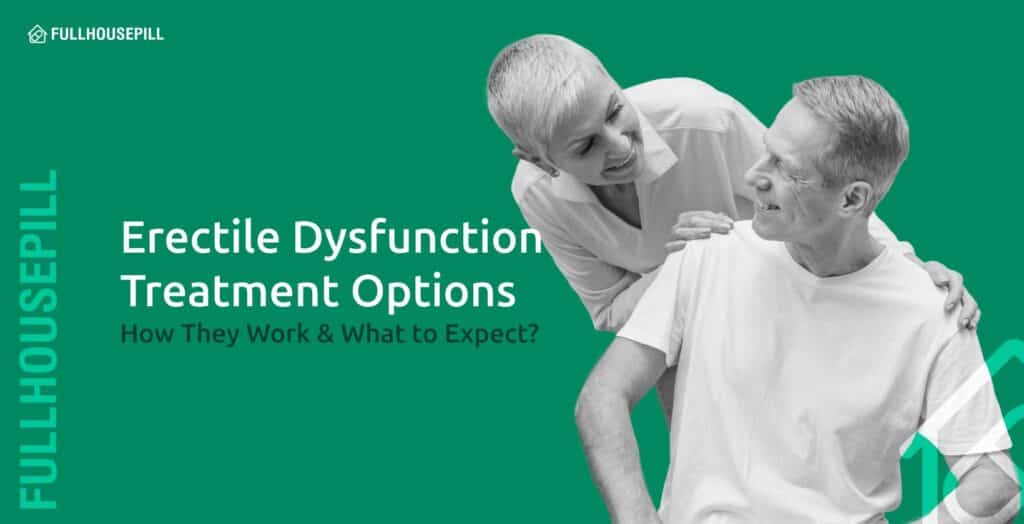Erectile dysfunction (ED) or impotence refers to the condition in which a man is persistently unable to get or maintain erections. A study published in the Therapeutics Letter by the University of British Columbia mentioned that in ED, the penile erection is not firm enough for satisfactory sexual activity like vaginal penetration in at least 50% of attempts.
A study published in StatPearls by Stephen W. Leslie and Thushanth Sooriyamoorthy mentioned that erectile dysfunction is extremely common, affecting 40% of men by the time they reach 40. In the United States alone, 20 million men are affected by ED, and its prevalence increases with age.
Understanding how to treat erectile dysfunction is crucial for overcoming difficulties with erections and maintaining good sexual health.
The treatment depends on ED etiology i.e., causes or origins of the problem. The causes can be diverse (i) organic, (ii) psychogenic (psychological), and (iii) mixed.
Organic ED can be caused by an underlying physical problem e.g., diabetes, cardiovascular disease, liver disease, hormonal problem, neurologic disorder, injury such as fracture etc.
Psychogenic ED or mental ED can be caused by performance anxiety, depression, lack of self-esteem, relationship-related difficulties, past trauma e.g., childhood sexual abuse etc. Mixed ED can stem from both psychological and physical causes.
It is possible to treat and reverse ED. Common types of treatments for erectile dysfunction include:
- Erectile Dysfunction Medication (PDE5 inhibitors): ED pills like sildenafil (Viagra), tadalafil (Cialis), and vardenafil (Levitra) can help men get harder erections by inhibiting the PDE5 enzyme, and promoting NO/cGMP‐mediated smooth muscle relaxation.
- Lifestyle Changes and Natural Remedies: A balanced diet, regular exercise, smoking cessation and limited alcohol intake can improve circulation and help men with ED.
- Testosterone Replacement Therapy (TRT): TRT is prescribed to men with testosterone deficiency that may be contributing to ED or other male sexual dysfunction.
- Penile Injections (Intracavernosal): Penis injections involve directly injecting medications like papaverine, phentolamine, prostaglandin E1, PGE1 or alprostadil into the penis to support more firm erections. Trimix, the combination of alprostadil, papaverine, and phentolamine, is a common ED treatment option.
- Intraurethral Suppository: A small pellet of medication inserted into the urethra (the tube that transports urine) to get more rigid erections. MUSE (medicated urethral system for erection) was a popular urethral suppository containing alprostadil used to treat erectile dysfunction.
- Vacuum Erection Devices (VEDs or Penis Pumps): A special device that mechanically creates a vacuum inside the penis by distending the corporeal sinusoids and causing a firm erection.
- Shockwave Therapy (Low-Intensity Extracorporeal Shock Wave Therapy – LI-ESWT): Shockwave therapy involves using noninvasive, acoustic waves through the penile tissues to improve erectile function.
- Penile Surgeries: Penis surgeries include surgically implanted penile prosthesis (inflatable or malleable) or vascular reconstructive surgery aimed to overcome ED.
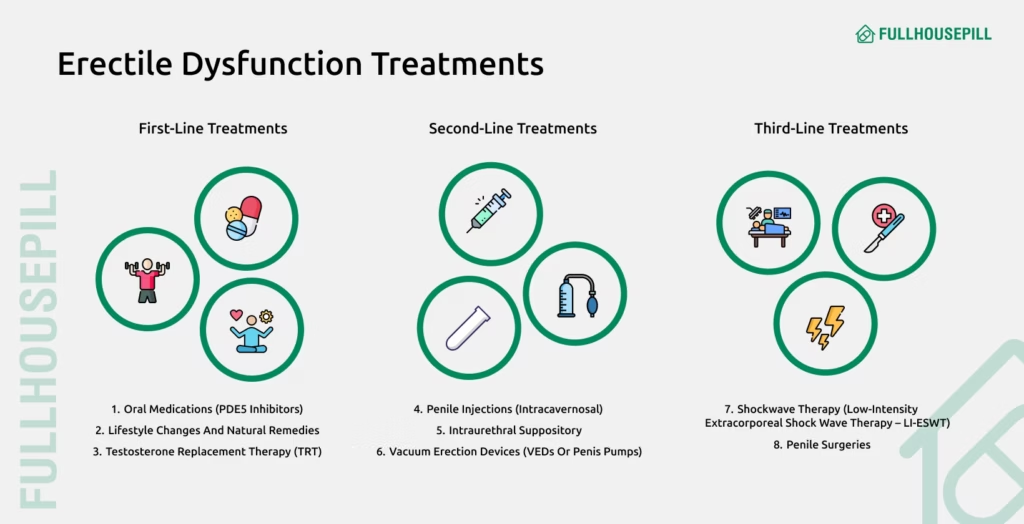
Men with successful erectile dysfunction treatments can enjoy harder, longer-lasting erections, sexual satisfaction, improvement in relationships, confidence, and overall quality of life.
Viagra and Other Oral PDE5 Inhibitor Medications: First-Line ED Treatment Options
Phosphodiesterase 5 Inhibitors (PDE5Is) are an FDA-approved treatment for erectile dysfunction and are available in the form of oral tablets. These are non-invasive, convenient, and generally well-tolerated ED treatment options. Some commonly available oral ED medications include:
- Sildenafil (Viagra): A phosphodiesterase type 5 (PDE5) inhibitor that improves nitric oxide–induced smooth muscle relaxation in the corpus cavernosum (the tissue responsible for erection). It starts working in about 30–60 minutes and lasts for about 4–6 hours.
- Tadalafil (Cialis): A PDE5 inhibitor with a half-life of about 17.5 hours, which allows erections to last longer—up to 36 hours. The drug typically starts working within 30–60 minutes while giving more flexibility and spontaneity with the timing of erections. It’s also approved for daily use in lower doses for men with ED.
- Vardenafil (Levitra): A highly selective PDE5 inhibitor with a structure similar to sildenafil, which also encourages blood flow to the penis during sexual arousal for harder erections. However, vardenafil is 10 times more potent than sildenafil, requiring fewer doses to achieve the same effects. This may lead to fewer side effects. Vardenafil’s effects last about 4–5 hours.
- Avanafil (Stendra): A second-generation PDE5 inhibitor with a rapid onset 15–30 min, faster than the other PDE-5 inhibitors. The duration of the action is up to 6 hours.
By inhibiting the enzyme PDE-5, these medications stop cGMP from breaking down within the smooth muscle cells of the penis. This leads to increased levels of cGMP in the vascular smooth muscle. As a result, the blood vessels are dilated or relaxed, allowing more blood to flow inside the penis, specifically, the corpus cavernosum tissue. Relaxation of blood vessels causes the erection to last longer, enhancing satisfaction in sexual pleasure and intimacy.
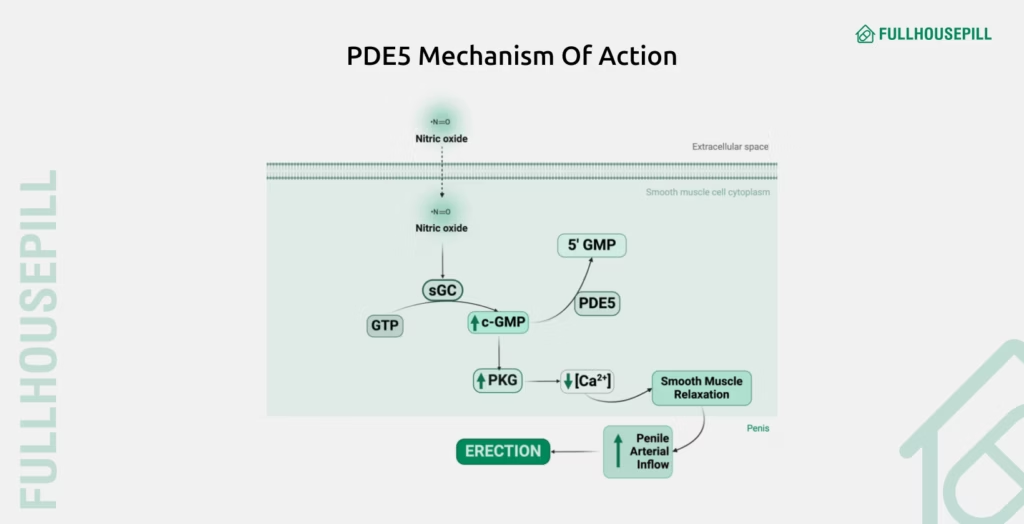
The mechanism of action of PDE5 inhibitors: Source: “Phosphodiesterase Type 5 Inhibitors in Male Reproduction: Molecular Mechanisms and Clinical Implications for Fertility Management”, Journal: Cells
The majority of men with ED are satisfied with the use of oral prescription ED drugs like sildenafil (Viagra). A study published in the World Journal of Men’s Health by Nam Cheol Park et al. shows that the success rate of PDE5 inhibitors is significantly high, at about 70%.
PDE5 Inhibitors have their limitations as well. These drugs may not be safe for all men with ED, especially those who are taking certain medicines like nitrates for chest pain (angina).
Note that Viagra, Cialis, and similar oral medications temporarily relieve the symptoms but do not offer a permanent cure for ED. They do not treat the underlying medical condition either (e.g., if the ED is caused by diabetes or a heart problem).
Side effects include mild headache, muscle ache, stomach upset, nasal congestion, dizziness and nausea, and temporary vision problems (a slight blue tinge).
Severe side effects may include priapism (painful, uncomfortable erection lasting longer than four hours). Sudden hearing or vision loss is rare but requires immediate medical attention if any signs occur. Before taking any medication, discuss possible risks and benefits with your doctor.
About 30% of patients do not respond to oral ED drugs as mentioned in the book Practical Tips in Urology. Other alternative therapies are recommended to certain groups because either the ED pills are not safe for them or do not work well for them.
Penile Injection Therapy for Erectile Dysfunction
Penile injection therapy helps treat erectile dysfunction in men who are unable to get adequate erections with oral ED medications like Viagra. It involves injecting medication directly into the penis (corpora cavernosa) to increase blood flow, thereby improving erections.
This treatment is also known as intracavernosal injection therapy (ICI).. The injection is administered at home, by the man himself or his partner, 5-15 minutes before sexual intercourse.
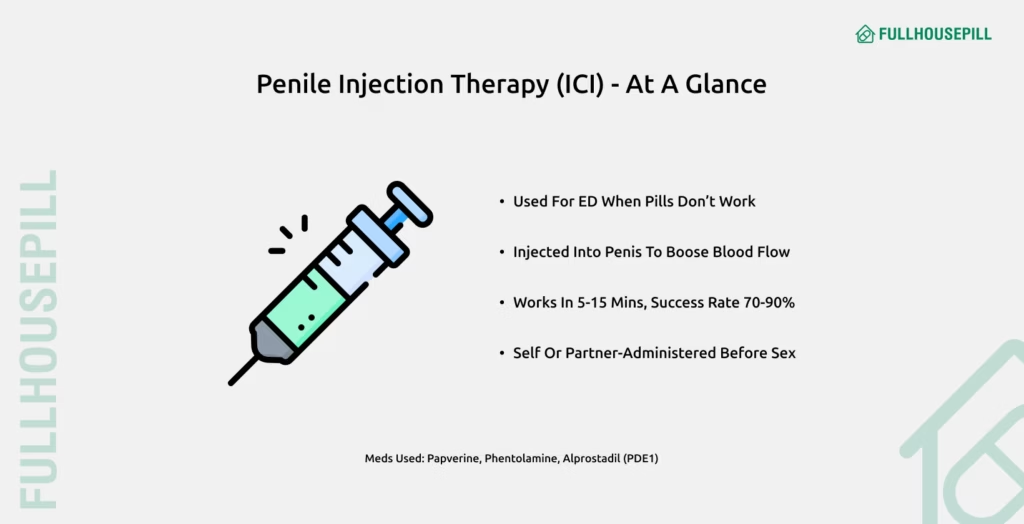
A study published in the Journal of Urology by John P. Mulhall and colleagues mentioned that the success rate of penile injections for erectile dysfunction is 70–90%, making it one of the most effective erectile dysfunction cures.
Types of medications used in penile injections include:
- Papaverine
- Phentolamine
- Prostaglandin E1 (PGE1, alprostadil)
Trimix is an effective penile injection for ED treatment, which combines all these three drugs. These medications help blood vessels to dilate or widen, which improves blood flow into the penis, inducing an erection.
After penile injections, some men may still need stimulation e.g., foreplay for the erection to appear while others do not need it.
Which injection is the best for erectile dysfunction depends on several factors e.g., severity of erection problems, and the person’s health and preferences.
A study published in The Journal of Urology by A. Bechara et al. showed that a treatment combining papaverine with phentolamine is as effective as prostaglandin E1 in helping men achieve and maintain an erection, but causes less pain than PGE1.
Another study published in European Urology by L.C. Liu et al. in 1991 revealed that prostaglandin E1 lasts longer and has a lower risk of priapism, a prolonged and unwanted erection sometimes caused by penis injections.
Combination erectile dysfunction injections like Trimix may provide better results than single-medication injections (e.g., alprostadil alone), as mentioned in Alprostadil, a book published in StatPearls authored by Leslie, Jain, and Iqbal.
While generally safe for most men with ED, some patients may experience side effects from penile injections, including minor pain and mild bleeding. Seek emergency care immediately if the erection lasts for more than 4 hours (priapism) or if any signs of infection, scars or bruising occur at the injection site.
To avoid risks, learn the injection technique from your healthcare provider before self-administering at home. Take the dose just as prescribed and as directed (e.g., whether at the base or side of the penis).
Intraurethral Medicine for the Treatment of ED
Intraurethral medication for erectile dysfunction involves inserting a suppository (a special form of medication e.g., dissolvable pellets) into the urethra. Doctors may prescribe this treatment option for men who do not respond well to oral ED medications e.g., PDE-5 inhibitors. This is a less invasive therapy than penile surgery or injection.
Alprostadil urethral suppository is basically a small pellet (containing the medicine alprostadil) gently inserted from the head of the penis into the urethra using an applicator. The pellet melts, dissolves inside the urethra through the mucosal lining and alprostadil enters the bloodstream.
Alprostadil is a vasodilator which helps in relaxing blood vessels and increasing blood flow into the penis, causing an erection. The suppository starts working in 5-10 minutes after insertion.
The mechanism of alprostadil does not depend on sexual stimulation to initiate an erection. So, you do not need foreplay before intercourse as the arousal becomes automatic, unlike PDE-5 inhibitors (e.g., Viagra and Cialis).
MUSE or “medicated urethral system for erection” was an FDA-approved alprostadil suppository. However, MUSE has been discontinued since June 2024.
According to the Penn Clinical Manual of Urology (Third Edition, 2024), intraurethral alprostadil is effective in 30–40% of cases and is less invasive compared to injections..
However, penile injections still have a much higher success rate in smooth muscle relaxation in the penis and helping men get and maintain erections, making it a more successful erectile dysfunction cure.
The side effects of an intraurethral suppository may include mild pain and minor bleeding. Serious adverse effects like priapism are rare (less than 5% cases).
For information about available urethral suppository options, consult your healthcare provider.
Testosterone Replacement Therapy (TRT) to Treat Male Sexual Dysfunctions
Testosterone replacement therapy (TRT) is a treatment option for men suffering from erectile dysfunction due to low serum testosterone levels.
Testosterone is an active androgen (male sex hormone) that regulates male characteristics and sexual behaviour.
The deficiency of testosterone is also known as male hypogonadism, in which the men’s testicles or testes cannot produce enough testosterone. It may result in sexual dysfunctions e.g., low sex drive and trouble getting an erection during sex.
The treatment involves correcting the hormone imbalance by using testosterone injections, patches, gels, creams, oral medications or palettes. It’s also called androgen replacement therapy (ART) and it’s an FDA-approved treatment.
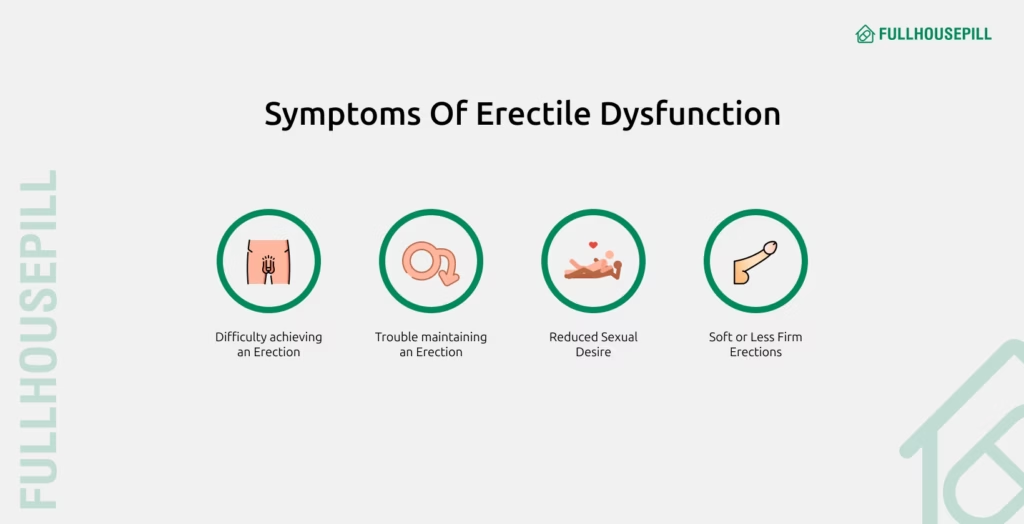
According to a literature review published in the American Journal of Medicine, about 65% of men with hypogonadism experienced better erections with testosterone replacement therapy. By raising testosterone levels, TRT helps relieve ED symptoms.
The therapy also increases the chances of multiple intercourse, orgasm, and overall sexual satisfaction, as per a guideline by the European Association of Urology.
Note that the relationship between erectile function and testosterone is still being investigated. Hypogonadism can increase the risk of ED but it is not a common cause. So, boosting testosterone isn’t always the solution to erection problems. Only a doctor can properly diagnose the cause of your ED and prescribe appropriate treatment.

While TRT is safe in general, it is not meant for people with certain health conditions e.g., heart problems, urinary problems and enlarged prostate. So, discuss potential side effects and contraindications of TRT with your doctor and compare with the other cures for ED.
Penis Pumps or Vacuum Erection Devices to Treat Impotence in Men
A vacuum constriction device (VCD) or a penis pump is a device consisting of a pump, a tube, and a constriction band that helps men get and keep an erection. This device is also called VED (vacuum erectile device) because it is used to manage erectile dysfunction.
When ED medicines (Viagra, Cialis etc.) do not work or cause side effects, penis pumps are a viable alternative. A VCD is an external, non-invasive treatment, unlike penis injections or surgeries.
The erectile tube fits over the penis. The pump attached to the tube can be electric or manually operated (operated by hand). When the pump is turned on, or hand pumped, the air is pulled out of the tube, creating a vacuum inside it. The vacuum encourages blood flow into the erectile tissue corpora cavernosa, allowing the penis to be hard.
When the erection occurs, the rubber ring or band is placed around the base of the penis. The band helps maintain the erection by restricting the blood from flowing out of the erect penis. After the vacuum tube is removed, the band is left in place for up to 30 minutes, so the erection usually lasts for 30 minutes.
A study by R.W. Lewis et al., titled “External Vacuum Therapy for Erectile Dysfunction: Use and Results,” showed that vacuum erection devices work very well, with a clinical success rate of about 90%. To increase the chances of success, vacuum devices are used along with other methods of treatment like oral ED medications.
The vacuum pump makes the penis appear bigger by temporarily increasing blood flow to the penis. There’s a visible increase in length and circumference when the penis is erect. So, the device is also known as a “penis enlargement pump”. However, it does not cause a permanent increase in the penis size.
The cost of a vacuum erection device for ED ranges from $100 to $500, depending on the brand and features e.g., automatic suction, whether the pump is hand-operated or run on batteries.
In certain severe cases e.g., when there’s a physical trauma impacting blood flow into the penis, VEDs may not work.
When first and second-line ED treatments fail, surgery may be recommended.
Penile Surgery to Permanently Cure Erectile Dysfunction
Erectile dysfunction surgery refers to the operative procedures used to restore blood flow to the penis, making it hard enough for sexual intercourse. When a patient is unresponsive to other treatments e.g., shots, vacuum pumps, or oral medications for erectile dysfunction, the doctor may recommend surgery.
Two common surgical options for ED patients are penile implant surgery and penile vascular surgery.
Penile implant surgery or penile prosthesis
Penile implants involve placing a firm or inflatable prosthetic device inside the penis to treat erectile dysfunction in men.
There are two main types of penile prosthesis:
- Inflatable penile implant: A hydraulic, fluid-filled prosthetic device that can be pumped to cause an erection when needed. Other times, it can be deflated back into a flaccid state.
- Non-inflatable penile implant: Prosthesis consisting of “malleable” or flexible semi-rigid rods. The material can be silicone. The rods, surgically placed inside the penis, keep the penis semi-hard all the time. The prosthetic does not need inflation or deflation.
A 2022 study published in The Journal of Sexual Medicine by Eusebio Luna et al. showed that over 93% of patients are satisfied with the outcome of penile prosthesis, making it a highly successful treatment for erectile dysfunction.
Penile implants last for about 5-15 years, even so, their efficacy may decrease over time. Mechanical failure rarely happens in the first year (less than 5% cases) while chances of infection are even less (3%).
Penile vascular reconstruction surgery
A surgery to treat or replace damaged blood vessels (arteries or veins) inside the penis. This allows the blood to move freely and improve erections sufficient for sexual satisfaction.
Microsurgical penile revascularization is a type of penile vascular surgery, done using which involves connecting the inferior epigastric artery (a donor artery or a donor blood vessel) to the dorsal penile artery (recipient artery).
Blood vessels (arteries and veins) are very small, so they can only be operated using a microscope. Hence, the procedure is “microsurgical”. “Vascular” means relating to blood vessels that carry fluids like blood.
A 2024 study published in the Journal of Medical Investigation by Yasuo Kawanishi et al. mentions that the long-term success rate of microsurgical penile revascularization is 60–70% in young men who have had pelvic trauma or injury to the perineum affecting their penile blood flow.
| Penile Implant Surgery (Prosthesis) | Penile Vascular Reconstruction Surgery | |
| Who is it for? | Men with severe erectile dysfunction not responding to other treatments | Men with ED caused by a block or damage in penile arteries or veins, often younger men (below 50) with issues related to physical trauma/injury |
| Procedure Type | Implanting a device inside the penis | Surgery to repair or bypass damaged blood vessels |
| Recovery Time | Moderate to long (weeks to months) | Varies; can take longer than implant surgery |
| Durability | Device lasts 5-15 years or more | Depends on the success of repair of the artery or vein; can be long-lasting |
| Risks | Infection, mechanical failure | Common risks associated with surgery |
| Effect on Natural Erections | Usually stops natural erections | Aims to restore natural blood flow and erectile function |
| Cost | $5,000 – $25,000+ | Can vary; depends on how complicated the procedure is, often very expensive |
Surgery is often a last resort when all other treatments fail. However, it is a long-term solution or a permanent “cure” for erectile dysfunction in certain cases e.g., when a blood vessel is damaged or blocked in the penile region which needs to be repaired with surgery.
Men who have erection problems first go through an extensive medical history and physical tests to find the cause of their ED and their overall health. Then the doctor can decide if surgery is the right option for them.
Erectile dysfunction surgery costs range usually between $5,000 and $25,000. The expenses may vary based on the severity of the problem, the surgeon’s experience, the location of the hospital and the facilities.
Penile pumps, shots, and surgeries have high success rates and patient satisfaction. Nonetheless, to naturally relieve symptoms of ED, doctors advise their patients to try simple lifestyle changes.
Lifestyle Changes to Naturally Overcome ED
Various research findings suggest that men can get harder erections naturally by making lifestyle changes such as eating a balanced diet, managing stress and getting enough physical activity.
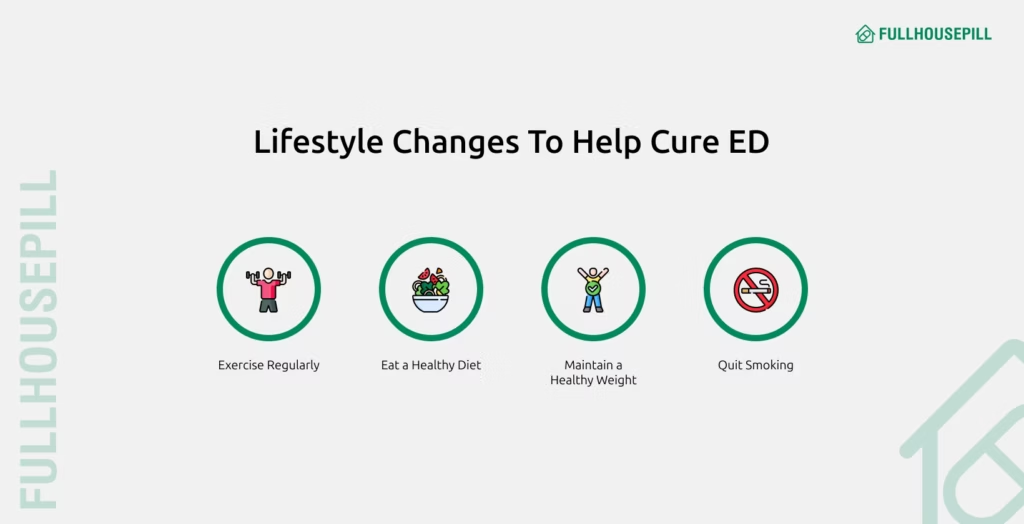
Source: Asian Journal of Andrology, “Lifestyle modifications and erectile dysfunction: what can be expected?”
- Physical activity and weight management
A study by Gerbild et al. (2018) in Sexual Medicine found that engaging in physical exercise 160 minutes a week for six months can help reduce ED caused by inactivity, obesity, high blood pressure and related health problems.
Exercising regularly can boost circulation, testosterone levels, reduce inflammation and help you maintain a healthy weight. Losing extra weight, especially around the abdomen, can build confidence and chances of harder erections.
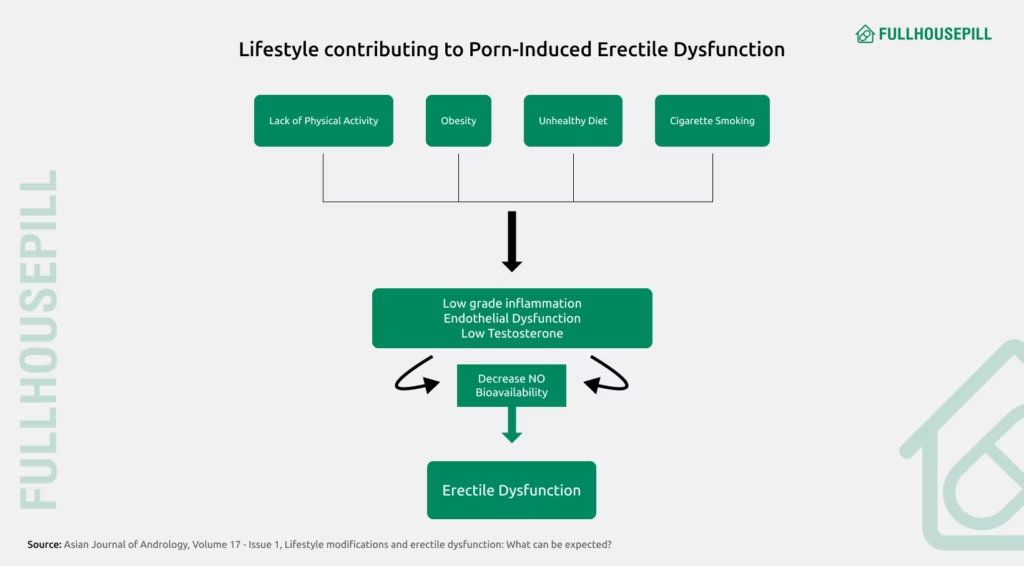
Pelvic floor muscles are crucial in achieving an erection. Increasing strength and toning up the pelvic region with Kegel exercises, yoga, and pilates can enhance neuromuscular control over your erections, increasing penis rigidness, sexual pleasure and satisfaction.
A study titled “Randomised Controlled Trial of Pelvic Floor Muscle Exercises and Manometric Biofeedback for Erectile Dysfunction” by Grace Dorey et al. showed that pelvic floor muscle exercises combined with biofeedback can help treat erectile dysfunction.
- Nutrition and hydration
Eating nourishing meals with a variety of fruits, vegetables, whole-grain foods, legumes, nuts, and seeds can help improve erectile dysfunction. By reducing sugar intake, you can maintain blood sugar levels and improve cardiovascular health, essential for strong erections.
Drink adequate water as proper hydration maintains the body fluid balance, promoting healthy circulation and blood flow to the penis.
Eating a good diet and staying hydrated also improves energy levels and mood, which has a direct impact on sexual performance. A study by Scott R. Bauer et al., published in JAMA Network Open, found that a healthy diet is linked to lower chances of ED, suggesting that healthy eating may help maintain erectile health.
- Mental and emotional health
Lack of sleep and chronic stress can affect your ability to enjoy intimacy and prevent you from getting and maintaining erections. Erectile dysfunction can occur if you have anxiety, stress, or just generally tired.
A study titled “Erectile Dysfunction and Sleep-Related Bruxism: An Exploratory Review of an Improbable Association” by Monica Levy Andersen et al. suggested that healthy sleep may help protect against ED.
Performance anxiety and relationship problems can also hamper libido making it hard to get an erection. Relaxing techniques like meditation, breathing exercises, couples counseling, talk therapy, stress management, and adequate sleep can improve your overall health and naturally reduce ED.
A study by Ahmad Bilal et al., published in Sexual Medicine, found that CBST is a promising treatment for younger men with nonorganic erectile dysfunction (NOED).
- Substance use and alcohol consumption
Alcohol and smoking can interfere with the nerve cells in the central nervous system, which plays a vital role in getting an erection. Avoiding harmful substance use (drugs or tobacco) and moderation in alcohol consumption can help men improve their erectile function.
A study by Aravind Karunakaran et al., published in The Journal of Sexual Medicine, showed that 88.5% of men experienced improvement in ED after three months of alcohol abstinence.
- Vitamins, minerals and herbal supplements
Some dietary supplements or herbal medicines are believed to work well in overcoming erectile dysfunction. Asian ginseng, ginkgo, Yohimbe, horny goat weed, bindii, and Ashwagandha are some herbs for ED traditionally used in the management of male sexual dysfunctions.
Studies show that B complex vitamins, vitamin D, zinc, L-arginine, DHEA or dehydroepiandrosterone are some supplements that may help improve sexual performance. A study published in Translational Andrology and Urology by Wei Wang et al. found that vitamins B6, B12, and folate may lower the risk of erectile dysfunction in younger, healthier men.
However, we don’t have enough data to recommend herbal or dietary supplements as a proven erectile dysfunction treatment option.
- Medical attention when necessary
When erection problems are persistent, or are triggered by an underlying health problem (e.g., a cardiac or vascular disease, hormone imbalance), natural therapies alone will not work. Combining healthy lifestyle habits with meds for ED and other methods can provide optimal results.
Shockwave Therapy (SWT) for Erectile Dysfunction Treatment
Shockwave therapy is a non-invasive medical treatment that uses low-frequency sound waves through the tissues of a targeted area in the body to improve blood flow and stimulate healing mechanisms.
In erectile dysfunction, low-intensity extracorporeal shock wave therapy (LI-ESWT) involves targeted passing of gentle shockwaves to improve blood flow in the penis, thereby improving penis hardness and erections. Shockwave therapy may be an option when ED pills are not working and to avoid invasive therapies like penis surgery or injection.
In the procedure, low-intensity shock waves are passed through the penis, creating a stress in the penile tissue. This process is believed to heal, grow, and strengthen blood vessels.
A study by Zubairu S. Musa et al., published in Arab Journal of Urology, showed that Li-SWT treatment was safe and effective for 63.5% of men with erectile dysfunction who did not respond to oral ED medications. Note that the treatment benefits are not permanent as its desired effects on erectile function seem to decline after 2 years.
Shockwave therapy is an experimental therapy for erectile dysfunction and it is still not approved by the FDA. We need more data to confirm its benefits and risks on ED and men’s overall health.
What Are The Best Treatment For Erectile Dysfunction?
The best treatment for erectile dysfunction (ED) combines lifestyle changes, oral medications, and psychological support, with advanced therapies reserved for persistent or complex cases. The right approach depends on the underlying cause, medical history, and personal preference. For most men, first-line treatment begins with improving physical and mental health. Lifestyle interventions often restore erectile function in mild cases. For others, pharmacological support or mechanical aids may be necessary. The treatment for erectile dysfunction can be customized using the options below.
1. Lifestyle Changes
Healthy habits can improve erectile function by supporting heart health and hormone levels. A balanced diet and regular exercise help circulation and testosterone production. Quitting smoking and limiting alcohol protect blood vessels and hormonal balance. Managing stress through therapy, meditation, or better sleep reduces psychogenic ED.
2. Oral Medications (PDE5 Inhibitors)
PDE5 inhibitors like sildenafil, tadalafil, vardenafil, and avanafil increase blood flow to the penis during sexual stimulation. These are the most effective first-line medications for ED. They differ in onset and duration. They are not suitable for men on nitrates or with heart instability.
3. Psychological Counseling
ED caused by anxiety, depression, or relationship issues may improve with therapy. Cognitive-behavioral therapy (CBT), sex therapy, or couples counseling can help reduce stress, improve self-esteem, and restore sexual confidence.
4. Advanced Medical Therapies
Penile injections (e.g., alprostadil) work for men who don’t respond to pills. Vacuum devices draw blood into the penis using suction. Penile implants offer a permanent solution via surgery. Hormone therapy helps when ED is linked to low testosterone. Shockwave therapy (Li-ESWT) boosts blood flow by stimulating penile tissue.
Comparison Table: Treatment Options at a Glance
| Treatment Type | Mechanism | Effectiveness | Best For | Considerations |
| Lifestyle Changes | Improves overall vascular and metabolic health | Moderate (varies) | Early-stage ED, general wellness | Requires consistency and time |
| Oral Medications | Enhances blood flow via PDE5 inhibition | High (60–80%) | Most men with functional ED | Avoid in men on nitrates |
| Psychological Counseling | Addresses mental and emotional factors | Moderate to high | Psychogenic ED | Requires time and emotional investment |
| Penile Injections | Direct pharmacological erection induction | High (up to 90%) | Non-responders to oral therapy | Invasive; may cause discomfort |
| Vacuum Devices | Mechanical blood draw into penis | Moderate to high | Men avoiding medication | May cause bruising or temporary discomfort |
| Penile Implants | Manual control of erection | Very high (95%+) | Severe or refractory ED | Surgical risks; irreversible |
| Hormone Therapy | Replaces deficient testosterone | Moderate | Hypogonadal men with ED | Requires hormone level testing |
| Shockwave Therapy | Stimulates neovascularization | Experimental/moderate | Mild vascular ED | Not widely available; more studies needed |
What Are The Best ED Pills?
The ED pills are oral medications called phosphodiesterase-5 (PDE5) inhibitors, which improve erectile function by increasing blood flow to the penis during sexual stimulation. These are considered the standard for treating erectile dysfunction in most men. The best ED pills include sildenafil for fast, affordable on-demand use, tadalafil for daily dosing or longer duration, avanafil for quick onset with fewer side effects, and vardenafil as a reliable alternative with strong efficacy. PDE5 inhibitors are also highly effective for men with diabetes-related ED, as they counteract poor vascular response. In some cases, metformin, a diabetes medication, may improve endothelial function and support the effects of ED pills.
Is Sildenafil Better Than Tadalafil For ED Treatment?
Tadalafil may be more convenient than sildenafil due to its longer-lasting effects. Both drugs are PDE5 inhibitors used to treat erectile dysfunction by enhancing penile blood flow during sexual stimulation. Clinical trials suggest that tadalafil is as effective as sildenafil in improving erection quality. However, many men prefer tadalafil because it remains active for up to 36 hours, compared to sildenafil’s 4 to 6-hour duration. This extended effectiveness allows for more flexibility in timing. In direct comparison, some studies evaluating sildenafil vs tadalafil have shown higher patient satisfaction with tadalafil, which may explain its growing preference as the first choice for ED treatment.
Which Erectile Dysfunction Drug Works Safely With Alcohol?
Tadalafil is generally considered safer with alcohol compared to sildenafil. While no ED drug should be combined with excessive drinking, studies show that moderate alcohol does not significantly interfere with tadalafil’s effectiveness or safety. In contrast, combining sildenafil and alcohol may increase the risk of dizziness, headaches, or a drop in blood pressure. Regardless of the drug, excessive alcohol reduces blood flow and lowers sexual performance, so moderation is essential.
How Much Does Erectile Dysfunction Treatment Cost?
The cost of erectile dysfunction (ED) treatment ranges widely, from $2 per dose for generic oral medications to $30,000 for surgical implants. Generic sildenafil or tadalafil is the most affordable option, especially through online platforms like Fullhousepill. Brand-name drugs cost more, though some insurance plans may offer partial coverage. Shockwave therapy, not typically covered by insurance, costs $400–$500 per session, with clinics offering discounted packages. Injections range from hundreds to over a thousand dollars per use, depending on the medication. Penile implants, a surgical solution, cost $15,000–$30,000 but may be covered if medically necessary. Other options include vacuum devices ($100–$700) and medical rings (~$750/year). Costs also vary based on location, clinic, and insurance. It’s essential to consult a doctor to choose the right ED treatment and understand total expenses.
What Is The Latest Treatment Available For Erectile Dysfunction?
The latest treatments for ED include shockwave therapy, stem cell therapy, and new formulations of PDE5 inhibitors. Low-intensity shockwave therapy is a non-invasive method that stimulates tissue repair and blood vessel formation in the penis. Stem cell therapy shows early promise but is still in the experimental stage. Oral strips and chewable forms of tadalafil and sildenafil are newer delivery methods offering faster absorption and convenience, especially for those who have difficulty swallowing pills.
How To Cure Erectile Dysfunction At Home?
Erectile dysfunction can be improved at home with consistent lifestyle changes. Reducing stress, maintaining a healthy body weight, and following an exercise routine can improve blood flow and testosterone levels. Limiting alcohol and quitting smoking also protect vascular health. A diet rich in foods like spinach, salmon, beets, and dark chocolate supports nitric oxide production, which is essential for erections. Home remedies may not fully cure ED but often reduce its severity.
Which Foods Help Treat Erectile Dysfunction Naturally?
Certain foods improve circulation, hormone levels, and endothelial health to support better erections. Hard erection foods include leafy greens like spinach (rich in nitrates), fatty fish like salmon (high in omega-3), and berries (loaded with antioxidants). Watermelon and pomegranate also help by enhancing nitric oxide production. A diet focused on these foods supports vascular function and may help restore erectile firmness naturally.
Which Vitamins Help To Improve Erectile Strength?
Vitamins B3, C, D, and E improve erectile strength by enhancing blood flow and reducing inflammation. Vitamins for ED are often recommended alongside foods like eggs (rich in B vitamins), citrus fruits (high in vitamin C), mushrooms (source of vitamin D), and almonds (rich in vitamin E). These nutrients improve endothelial function and testosterone levels, both vital for strong erections. When included in the diet, these vitamins enhance the effect of natural and medical ED treatments.
How To Get a Stronger Erection?
Stronger erections are the result of improved circulation, hormone balance, and mental focus. Regular aerobic exercise, stress control, and a nitric oxide-boosting diet all contribute. Foods rich in flavonoids, like dark berries and cocoa, support vascular health. Supplements such as L-arginine and ginseng may help but should be taken under supervision. Medically, PDE5 inhibitors help improve firmness by increasing blood flow. Lifestyle, food, and medicine together can lead to stronger erections.
How to Fix Erectile Dysfunction at a Young Age Naturally?
Young men can often reverse ED by addressing lifestyle habits and psychological stress. Key steps include reducing screen time, managing anxiety, getting adequate sleep, and avoiding substance use. Nutritional support and exercise help restore blood flow. While some assume age is not a factor, hormonal decline and poor lifestyle can cause early ED. Understanding the link between age and ED clarifies that erection issues can start even in the 20s, and early intervention is crucial for reversal.
